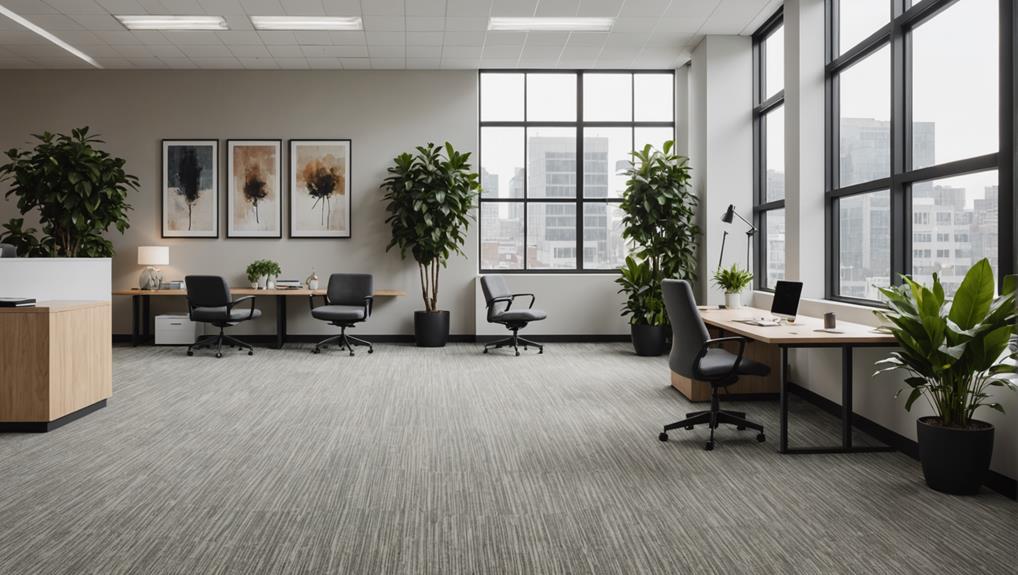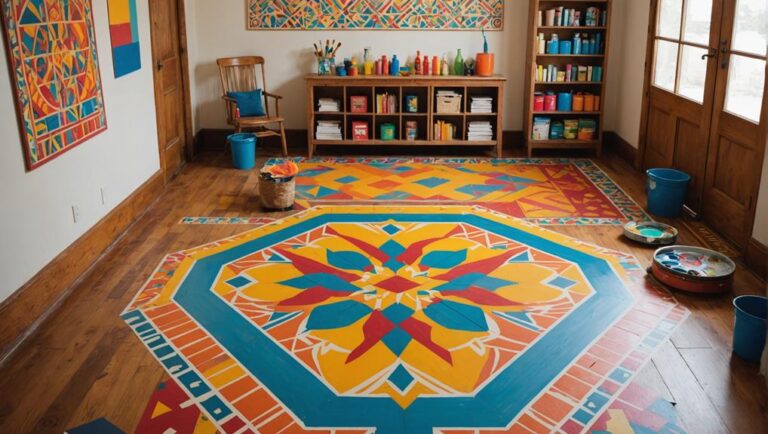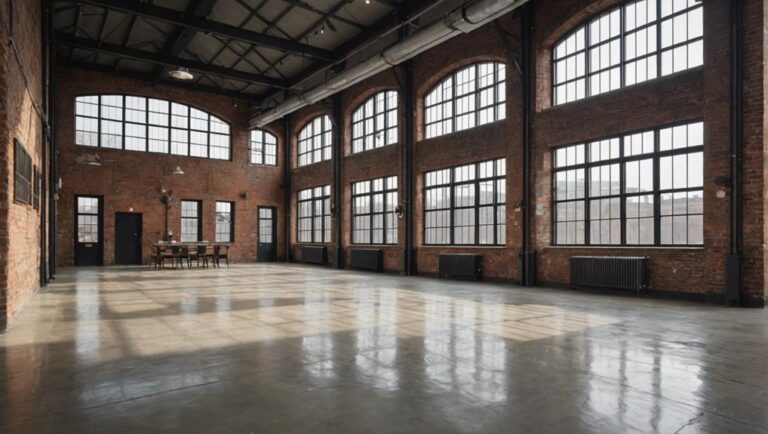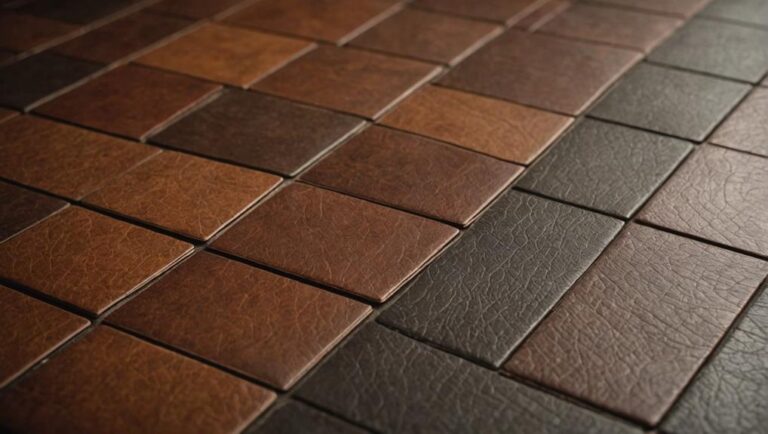To effectively reduce noise in your office, start with soft flooring materials like plush carpets or textured vinyl that absorb sound waves. Consider underlays to further dampen noise transmission. Strategically place area rugs to define zones and soften foot traffic, while acoustic tiles can transform echoes into a calm atmosphere. Regular maintenance keeps surfaces in top shape, and thoughtful furniture arrangements can create barriers to sound. Don't forget to assess foot traffic patterns, tailoring your flooring choices accordingly. Curious about more ways to enhance your office acoustics? You might find additional insights surprisingly beneficial.
Choose Soft Flooring Materials
Often overlooked, the choice of flooring material can profoundly impact the acoustics of your office space. You might not realize it, but the right flooring can absorb sound, making your work environment more serene and productive. Imagine stepping onto a soft, cushioned vinyl surface that gently muffles the hustle and bustle of everyday office life. This type of flooring not only feels pleasant underfoot but also serves as a barrier against noise, creating a calm atmosphere that promotes focus.
Now, think about plush carpets. Their thick, luxurious texture isn't just about aesthetics; it's about safety and sound reduction too. Carpeting provides a soft landing for footsteps, which minimizes the clatter of heels and the shuffle of shoes. Picture your colleagues moving about quietly, their conversations flowing naturally without the distraction of echoes bouncing off hard surfaces. By choosing plush carpets, you're investing in an environment that fosters communication and collaboration.
Safety is another key factor. Soft flooring materials can help reduce slips and falls, providing a stable surface for everyone. So, when you're selecting the right flooring for your office, consider cushioned vinyl and plush carpets. Both options can elevate your workspace, turning it into a haven of productivity and comfort. As you weigh your choices, remember that the right flooring doesn't just improve aesthetics; it can fundamentally change the way you and your team experience the workplace every day.
Install Sound-Absorbing Underlays
Choosing the right flooring material is just the beginning of creating a quieter workspace; integrating sound-absorbing underlays can take your noise reduction efforts to the next level. These underlays act as a cushion between the hard floor and your flooring material, minimizing sound transmission and providing a more pleasant acoustic environment. By selecting the appropriate underlay type, you'll enhance your office's comfort and safety.
Here's a quick overview of common underlay types and their installation methods:
| Underlay Type | Benefits | Installation Method |
|---|---|---|
| Foam | Lightweight, cost-effective | Rolls or sheets, easy to cut |
| Rubber | Excellent sound absorption | Glue down or double-sided tape |
| Felt | Eco-friendly, durable | Staple or glue down |
| Cork | Natural, thermal insulation | Glue down |
| Mass Loaded Vinyl | Heavyweight, superior soundproofing | Glue or peel-and-stick |
When you decide on the right underlay, consider factors like sound absorption rating, thickness, and compatibility with your flooring. Installation methods vary based on the underlay type, so be sure to follow manufacturer guidelines to guarantee peak performance.
Use Area Rugs Strategically
Imagine stepping into your office and feeling the soft embrace of an area rug underfoot, instantly muffling the clatter of chairs and footsteps. By choosing materials that absorb sound and defining distinct work zones, you can create a serene atmosphere that's both functional and inviting. Plus, a well-placed rug enhances your office's aesthetic, transforming a mundane space into a stylish haven.
Choose Appropriate Materials
In a bustling office, the right flooring can make all the difference in creating a serene atmosphere. When you choose appropriate materials, you not only enhance aesthetics but also reduce noise. Consider area rugs crafted from thick, durable fibers; they absorb sound and soften footsteps, transforming hard surfaces into cozy havens. Opt for flooring colors that complement your office's branding while contributing to a calming environment. Soft blues or earthy tones can evoke tranquility and focus.
Material durability is key, too. You want flooring that withstands the daily grind of office life. Look for options like carpet tiles or vinyl with sound-absorbing underlayments. These materials are not only tough but also easy to maintain—essential for a busy workplace.
Strategically placing area rugs in high-traffic areas can act as a barrier against noise, creating a quieter and safer space for your team. Think of it as both a protective layer and a style statement. Remember, your flooring choices reflect your commitment to a comfortable work environment. Prioritize durability and sound absorption to guarantee your office stays both stylish and peaceful.
Define Work Zones
Creating distinct work zones in your office can dramatically enhance both productivity and acoustics. By using area rugs strategically, you can define designated areas that not only reduce noise but also promote focus and collaboration. Imagine stepping into a workspace layout where each section tells a different story: a cozy rug under your desk to absorb sound, a vibrant mat in the brainstorming corner to stimulate creativity, and a plush carpet in a meeting area that fosters connection.
These rugs serve as visual cues, helping everyone understand where to focus on individual tasks or engage in group discussions. When you place them thoughtfully, you create boundaries that guide movement, reducing the chance of accidents in busy environments.
Additionally, the soft textures of these rugs can dampen foot traffic noise, making it easier to concentrate. They also add a layer of comfort, ensuring safety as people walk around, preventing slips or falls. By defining your work zones with purpose, you enhance not just the acoustics but also the overall ambiance of your office, making it a safer and more productive place to thrive.
Enhance Aesthetic Appeal
Strategically placed area rugs often transform an office's visual landscape, adding warmth and character to otherwise sterile environments. Imagine stepping into a space where soft textures complement sleek flooring, creating an inviting atmosphere. By choosing area rugs that harmonize with your color schemes, you can enhance the overall aesthetic while promoting a sense of safety.
Select rugs in hues that echo your branding or workspace theme, ensuring they blend seamlessly with the existing flooring textures. A plush, muted rug can soften hard surfaces, absorbing sound and reducing noise levels. Consider a vibrant, patterned rug to create a focal point, drawing attention to a collaborative zone or a cozy reading nook.
When placing rugs, think about their size and placement; larger rugs can delineate areas while smaller ones can accentuate furniture arrangements. This strategic use not only elevates the aesthetic but also provides slip resistance, making your office safer.
Opt for Acoustic Tiles
Imagine stepping into your office and feeling the hush envelop you like a cozy blanket—acoustic tiles can make that a reality. These sound-absorbing wonders not only muffle the clatter of busy feet but also add a stylish flair to your space. When considering installation, you'll want to guarantee you choose the right type and placement to maximize their benefits.
Benefits of Acoustic Tiles
Transforming your office space with acoustic tiles can greatly enhance the overall work environment. Imagine walking into a workspace where the chatter of colleagues and the hum of machinery fade into a soothing background. Acoustic tiles excel in sound absorption, considerably reducing echoes and unwanted noise, making it easier to focus on your tasks.
By integrating these tiles into your office, you're not just investing in aesthetics; you're prioritizing noise control that fosters a calm and productive atmosphere. Picture a meeting room where discussion flows freely without distractions, or an open office where creativity thrives amidst a peaceful ambiance.
Safety is also a concern. Acoustic tiles can be designed to meet fire safety standards, ensuring they won't compromise the well-being of your staff. Their installation can even contribute to better air quality, as many tiles are made from eco-friendly materials.
Incorporating acoustic tiles is more than a design choice; it's a commitment to creating a healthier, more efficient workspace. With their ability to enhance sound quality and reduce stress, you'll find that your office transforms into a sanctuary of productivity and focus.
Installation Considerations and Tips
Choosing the right installation method for acoustic tiles can make all the difference in achieving ideal sound reduction in your office. When you select your flooring types, keep in mind that the installation techniques vary based on material and design. If you're using adhesive tiles, verify the surface is clean and dry to prevent any unwanted lifting or bubbling. For interlocking tiles, precision is key; improper alignment can create gaps that let sound seep through, undermining your efforts.
Before you begin, consider the layout of your space. Measure carefully to minimize waste and maximize coverage. If you're installing over existing flooring, make certain it's suitable; some types can trap moisture, leading to mold or compromise safety.
And don't forget about underlayment! A quality underlayment can enhance the acoustic benefits of your tiles, providing extra cushioning and soundproofing.
Lastly, take your time during installation. Rushing through it can lead to mistakes that might not only affect acoustics but also pose safety hazards. With patience and attention to detail, you'll create a serene workspace that keeps distractions at bay.
Consider Carpet vs. Hard Surfaces
When it comes to office flooring, the choice between carpet and hard surfaces can significantly impact both acoustics and aesthetics. Imagine stepping into an office adorned with plush carpets; the soft fibers absorb sound, creating a serene work environment where conversations flow without echoing. Carpet benefits include not just noise reduction, but also warmth underfoot, providing a safe, slip-resistant surface that cushions falls, which is especially vital in high-traffic areas.
On the other hand, hard surfaces like tile or hardwood might look sleek and modern, but they come with a set of hard surface drawbacks. These materials can amplify sound, turning footsteps into disruptive thuds that ricochet off walls, making it difficult to concentrate. Additionally, hard surfaces can pose safety risks. They're often slippery when wet, increasing the chance of slips and falls—something you definitely want to avoid in a busy office.
While aesthetics may draw you to a trendy hard surface, remember the long-term implications it can have on your workplace environment. If you prioritize comfort and safety, opting for carpet could be your best bet. You'll create a quieter, more inviting atmosphere, where employees feel at ease and focused. So, as you weigh your options, consider how each flooring type aligns with your vision for a productive, safe workplace that promotes well-being and efficiency.
Maintain Flooring Regularly
Regardless of whether you've opted for the cozy embrace of carpet or the sleek allure of hard surfaces, regular maintenance is essential to preserving your office flooring's aesthetics and performance. Imagine stepping into your workspace, greeted by clean, pristine floors that reflect professionalism and attention to detail. To achieve this, establish a consistent cleaning schedule tailored to your flooring type.
For carpets, frequent vacuuming is vital to prevent dirt buildup that can muffle sound and harbor allergens. Invest in quality maintenance tools like a heavy-duty vacuum with HEPA filters to guarantee your carpets remain fresh and healthy. Don't forget to schedule deep cleanings, ideally every six months, utilizing steam cleaners or professional services to revive the fibers and maintain their integrity.
If you've chosen hard surfaces, a daily sweeping or dust-mopping routine can keep them free from debris, while a weekly damp mop with appropriate cleaners will maintain their shine and sound-absorbing qualities. Regularly inspect for scratches or dents, and be ready to address these issues promptly to avoid further damage.
Incorporate Noise Barriers
How can you transform a bustling office into a serene workspace? One effective approach is to incorporate noise barriers that create a peaceful atmosphere while enhancing sound privacy. These barriers can notably reduce distractions and improve concentration, making your office a haven for productivity.
Consider the following types of acoustic barriers to enhance your space:
| Barrier Type | Material | Benefits |
|---|---|---|
| Acoustic Panels | Foam, Fabric | Absorb sound, reduce echo |
| Partition Walls | Drywall, Glass | Create private areas |
| Carpeting & Rugs | Wool, Nylon | Dampen noise, add warmth |
| Acoustic Ceiling Tiles | Mineral Fiber | Minimize sound reflection |
Using these barriers strategically can help break up noise waves and prevent them from bouncing around your office. For instance, installing acoustic panels on walls not only softens sounds but also adds an artistic touch to your decor. Partition walls can create cozy nooks for focused work, promoting sound privacy while maintaining an open feel.
When you choose carpeting or rugs, think about plush textures that absorb sound, giving your space a comfortable vibe. Acoustic ceiling tiles can also be a game-changer, transforming hard surfaces into sound-absorbing components.
Arrange Furniture Thoughtfully
Strategically arranging your furniture can greatly impact the sound dynamics in your office. When you think about furniture arrangement, keep in mind that it can either amplify or absorb noise. In open spaces, clutter can create echoes that bounce around, making it difficult to focus. So, let's explore some thoughtful approaches to create a serene workspace.
- Group similar functions: Place desks together for collaborative work, while isolating quiet zones for tasks that require concentration.
- Use soft furnishings: Incorporate rugs, cushions, or upholstered furniture to dampen sound. They act as natural sound absorbers.
- Create barriers: Use bookshelves or plants to form subtle partitions that break up sound waves and enhance privacy.
- Consider traffic flow: Arrange furniture to avoid blockages, allowing easy movement while minimizing disruptions.
- Experiment with layouts: Don't hesitate to rearrange until you find a setup that feels right. Sometimes, a little tweak can go a long way!
Evaluate Foot Traffic Patterns
Once you've arranged your furniture thoughtfully, the next step is to evaluate foot traffic patterns in your office. Understanding how people move through your space is essential for enhancing both comfort and safety. By analyzing traffic flow, you'll identify high-traffic areas that may need additional noise-reducing measures.
Start with activity mapping. Observe how employees navigate the office during busy hours. Are certain paths consistently crowded? Do people tend to gather in specific spots? Gather data on these movements and jot down your findings. This will help you pinpoint where sound might bounce or amplify, impacting productivity.
Here's a simple table to visualize different traffic flow scenarios:
| Area | Foot Traffic Level | Suggested Flooring Type | Noise Reduction Solution |
|---|---|---|---|
| Entrance | High | Carpet Tiles | Acoustic Underlay |
| Meeting Rooms | Medium | Laminate | Area Rugs |
| Break Room | High | Vinyl Plank | Soft Mats |
| Hallways | Medium | Hard Tile | Wall Panels |
Once you've mapped out the activity, consider how flooring materials can absorb sound in those high-traffic areas. Opt for softer surfaces like carpet tiles or vinyl planks in places where people gather. This'll help minimize the noise and create a calmer workspace. By understanding and adjusting to foot traffic patterns, you'll not only enhance the noise levels but also foster a safer, more inviting office environment.
Frequently Asked Questions
What Types of Flooring Materials Are Best for Noise Reduction?
When you're considering flooring materials for noise reduction, think about carpet options and vinyl alternatives. Plush carpets absorb sound beautifully, creating a cozy, quiet atmosphere. If you prefer something more modern, vinyl options can provide a stylish look while still dampening noise. Imagine walking on soft, cushioned surfaces that keep distractions at bay, allowing you to focus better. Choosing the right flooring can enhance safety and comfort in your environment, making work a pleasure.
How Do Sound-Absorbing Underlays Work?
Sound-absorbing underlays work like a cozy blanket for your floors, reducing vibrations and creating a peaceful environment. These underlay materials, often made from foam or rubber, absorb sound waves, enhancing sound isolation. When you walk across the floor, instead of echoes bouncing off hard surfaces, the underlay muffles those noises, making your space feel safer and more serene. You'll notice a significant difference in comfort and tranquility, allowing you to focus better in your surroundings.
Can Area Rugs Be Effective in Open Office Spaces?
Imagine a cozy haven amidst the chaos of an open office, where area rugs play the role of silent guardians. You'll find that thoughtful area rug placement can soften sounds, creating a serene atmosphere. Choosing the right rug material, like plush wool or dense nylon, enhances this effect. By strategically placing these rugs, you not only enhance safety by reducing slips but also cultivate a warm, inviting space that encourages focus and collaboration.
Are Acoustic Tiles Suitable for All Office Environments?
When evaluating if acoustic tiles are suitable for all office environments, think about their benefits. They can greatly reduce sound, creating a more peaceful workspace. However, you'll need to take into account installation aspects, like whether your ceiling can support them. In quieter areas, they'll enhance focus, but in more dynamic spaces, the sound absorption might be less effective. Always verify safety standards are met during installation for a harmonious and secure workplace.
What Maintenance Practices Enhance Noise Reduction in Flooring?
Picture a serene office, where the gentle hum of productivity flows freely. To enhance that tranquility, you'll want effective floor maintenance. Regularly sweeping or vacuuming removes dust, while damp mopping with safe, non-toxic cleaners can deepen the shine and absorb sound. Don't forget to inspect and repair any damaged areas; they can disrupt the harmony. With these cleaning techniques, you'll create a safer, quieter space that fosters focus and collaboration.




